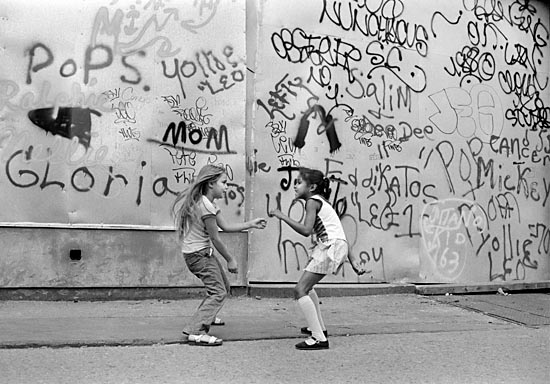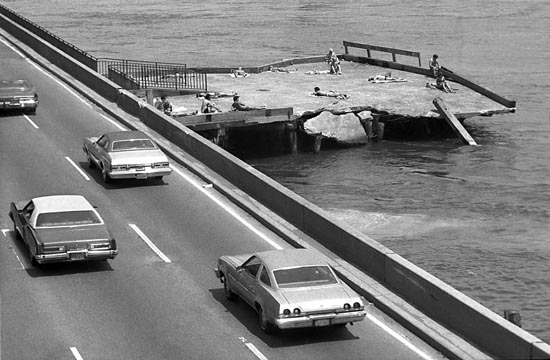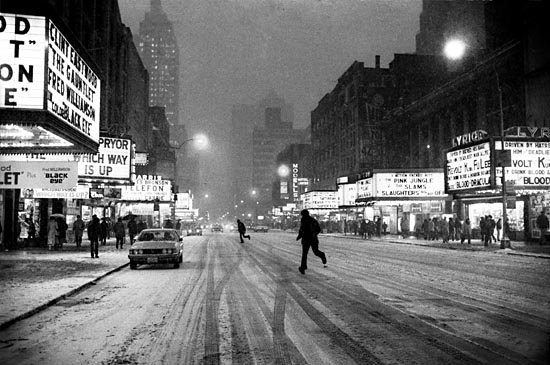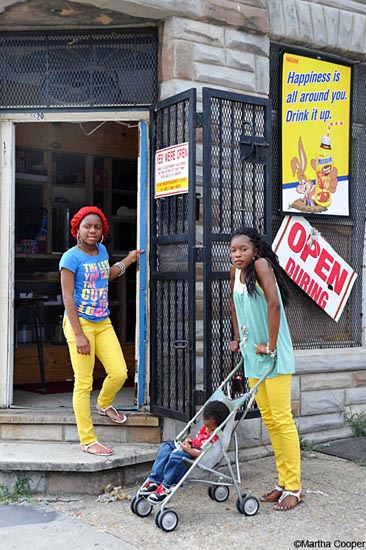This month, I had the opportunity to have a studio visit with legendary photographer Martha Cooper. We sat and “talked shop” about photography and New York City, thirty years back and now. I always knew of Martha Cooper, but there were things about her photographic career I only learned of that day. The 1980’s movie Beat Street – little did I know that she was the still photographer. Perhaps she is best known for her extensive coverage of the early Hip Hop days, as it emerged from the Bronx. These images have been published worldwide, helping make Hip Hop the predominant international youth movement it is today. Looking at her collection of images and many published books, (Street Play, Subway Art and New York State of Mind – to only name a few) it is evident that Martha had the desire to document NYC simply as it was, making images which hold views of complete authenticity which add to historic preservation.
Martha’s work has been exhibited in museums and galleries worldwide and published in numerous magazines from National Geographic to Vibe. She lives in Manhattan where she is the Director of Photography at City Lore, the New York Center for Urban Folk Culture. For the past five years Martha has been shooting a personal project in SoWeBo, a neighborhood in Southwest Baltimore.
Carissa Pelleteri: When you moved to New York in 1975 what neighborhood did you live in and why did you choose to spend a lot of your time documenting in the Lower East Side?
Martha Cooper: In 1975 I was married to an anthropologist and living in Rhode Island where he was teaching at URI. I was the staff photographer for two weekly RI newspapers but wanted to come to NY because that’s where all the editorial work was at the time. I didn’t know anything about the city but answered an ad in the Village Voice to share an apartment for 3 days a week. It happened to be on the Upper Westside. So I began commuting back and forth. Eventually I got my own apartment and a staff job with the New York Post. I continued to commute back and forth for 5 years until my (now-ex) husband managed to get a teaching job at Fordham and move to NYC. The Post was on the Lower East Side so I often drove through Alphabet City at the end of the day looking for photos to use up the remaining film in my cameras before going back to develop the rolls at the end of the day.
CP: While making the images that wound up becoming “Street Play” were you pretty much the only photographer (and woman) on the street with a camera? Many of the children, if not aware, seem to trust you taking these pictures. What was your approach?
MC: At the time that part of the Lower East Side looked like a war zone with whole blocks of abandoned buildings and vacant lots. It was known as an area of crime and drugs and people were afraid to go there at all much less with a camera. My approach was simply to drive around until I saw something I wanted to shoot and then get out and shoot. If you hang in long enough people usually ignore you and go back to what they’re doing. If things looked dicey, I could always hop back into my car. I’m doing the same thing today in Baltimore – but on foot.
CP: Tell me about the fateful meeting with Edwin (HE -3).
MC: One day one of the kids whom I’d previously photographed with his pigeon coop showed me a little notebook of drawings and asked me why I didn’t take photos of graffiti. He explained that he was practicing variations of his nickname, HE3, to paint on a wall. Until that point I hadn’t understood that kids were writing their names. The idea that kids were designing graffiti in notebooks fascinated me. HE3 offered to introduce me to Dondi–and the rest, as they say, is history…
CP: At the time, did you have any idea that the images you were making would have a dramatic impact on graffiti, the artists, hip-hop and its now worldwide phenomenon?
MC: Actually I thought the exact opposite. I thought I was photographing something that could only happen in New York City and that it would disappear quickly. I wanted to make a record of it in the spirit of historic preservation.
CP: When did you step away from the graffiti/hip-hop scene and for those 20 or so years, what were you working on?
MC: After Subway Art was published and Hip Hop became mainstream, I was no longer intent on photographing it as plenty of other photographers had jumped in. Also I’d left the Post so needed to get paying work to support myself. I’d always wanted to work for National Geographic so set my sights on that. For a while I was traveling a lot doing freelance assignments for them in exotic places like Ellesmere Island in the high arctic. I was also shooting some mundane corporate PR assignments to pay the bills.
CP: What do you think about a street photographers role in NYC now, compared to 30 years ago?
MC: Today, at least in NYC, everyone has a camera and is a street photographer. On the one hand it’s fascinating to look, via sites like Flickr, at what people are seeing on the street but on the other, there’s an incredible glut of photos.
CP: Your recent ongoing project in Baltimore has a similar feeling to the images made in the late 1970’s/80’s. Why are you documenting in Baltimore?
MC: I wanted to get back to the kind of photography I felt I was best at–candid shots of people doing things on the street. I needed to pick a place where there was a lot of street life. Baltimore is my hometown, so I decided to try to document a neighborhood there. I wanted to be able to go back repeatedly and shoot as it changed over time and to be able to interact with the people I was photographing. Over the past five years I’ve made about 125 trips to Baltimore on the bus.
CP: Any images, projects or persons that are especially close to your heart?
MC: My 21 year old cat, Pancho.
CP: Tell me about your next exhibition / project / book.
MC: I always have a lot of irons in the fire. I’m working on a book with my 1970 Japanese tattoo photos with a Swedish Publisher, Dokument. Also I’m preparing for two shows in LA in April. One is the Art in the Streets show at MOCA and the other is at the Carmichael Gallery. That one is called Martha Cooper Remix. I’ve asked graffiti and street artists to choose one of my photos and reinterpret in their own style. I’m also going to have a show at Viva House, a soup kitchen in SoWeBo, my Baltimore neighborhood. I wanted the people in my photos to be able to see what I’ve been up to.
Artists link: 12ozprophet.com/index.php/martha_cooper












 RSS
RSS
